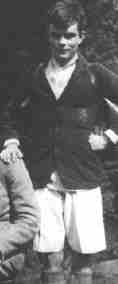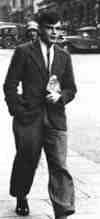|
|
Alan Turing: a short biography by Andrew HodgesThis short on-line biography of Alan Turing is based on the entry I wrote for the British Dictionary of National Biography in 1995. The eight parts correspond roughly to the eight sections of my full biography Alan Turing: the enigma.There are no hyperlinks in the text. For links and for more images, go to the corresponding page of the Alan Turing Internet Scrapbook. |
Part 2 — Matter and Spirit |
| Turing's private notes on the theory of relativity showed a degree-level appreciation, yet he was almost prevented from taking the School Certificate lest he shame the school with failure. But it appears that the stimulus for effective communication and competition came only from contact with another very able youth, a year ahead of him at Sherborne, to whom Alan Turing found himself powerfully attracted in 1928. He, Christopher Morcom, gave Turing a vital period of intellectual companionship — which ended with Morcom's sudden death in February 1930. | |
| Turing's conviction that he must now do what Morcom
could not, apparently sustained him through a long crisis. For three
years at least, as we know from his letters to Morcom's mother, his
thoughts turned to the question of how the human mind, and
Christopher's mind in particular, was embodied in matter; and
whether accordingly it could be released from matter by death.
This question led him deeper into the area of twentieth century physics, first helped by A. S. Eddington's book The Nature of the Physical World, wondering whether quantum-mechanical theory affected the traditional problem of mind and matter. |
 Alan Turing, 1931 |
|
As an undergraduate at King's College, Cambridge from 1931, he entered a world more encouraging to free-ranging thought. His 1932 reading of the then new work of von Neumann on the logical foundations of quantum mechanics, helped the transition from emotional to rigorous intellectual enquiry. At the same time, this was when his homosexuality became a definitive part of his identity. The special ambience of King's College gave him a first real home. His association with the so-called anti-War movement of 1933 did not develop into Marxism, nor into the pacifism of his friend and occasional lover James Atkins, then a fellow undergraduate mathematician, later musician. He was closer in thought to the liberal-left economists J. M. Keynes and A. C. Pigou. His relaxations were found not in the literary circles generally associated with the King's College homosexual milieu, but in rowing, running, and later in sailing a small boat. Turing's progress seemed assured, A distinguished degree in 1934 followed by a Fellowship of King's College in 1935 and a Smith's Prize in 1936 for work on probability theory, and he might then have seemed on course for a successful career as a mildly eccentric King's don engaged in pure mathematics. His uniqueness of mind, however, drove him in a direction none could have foreseen. | |
| By 1933 Turing had already introduced himself to Russell and Whitehead's Principia Mathematica and so to the then arcane area of mathematical logic. Bertrand Russell had thought of logic as a solid foundation for mathematical truth, but many questions had since been raised about how truth could be captured by any formalism. In particular, in 1931 Gödel had shattered Russell's picture by showing the incompleteness of mathematics: the existence of true statements about numbers which could not be proved by the formal application of set rules of deduction. In 1935, Turing learnt from the lecture course of the Cambridge topologist M. H. A. Newman that a further question, posed by Hilbert, still lay open. It was the question of Decidability, the Entscheidungsproblem. Could there exist, at least in principle, a definite method or process by which it could be decided whether any given mathematical assertion was provable? |  Alan Turing in 1934 |
| To answer such a question needed a definition of 'method' which would be not only precise but compelling. This is what Turing supplied. He analysed what could be achieved by a person performing a methodical process, and seizing on the idea of something done 'mechanically', expressed the analysis in terms of a theoretical machine able to perform certain precisely defined elementary operations on symbols on paper tape. He presented convincing arguments that the scope of such a machine was sufficient to encompass everything that would count as a 'definite method.' Daringly he included an argument based on the transitions between 'states of mind' of a human being performing a mental process. | |
Continue the short biographyFor links and more pictures go to the corresponding
| |
|